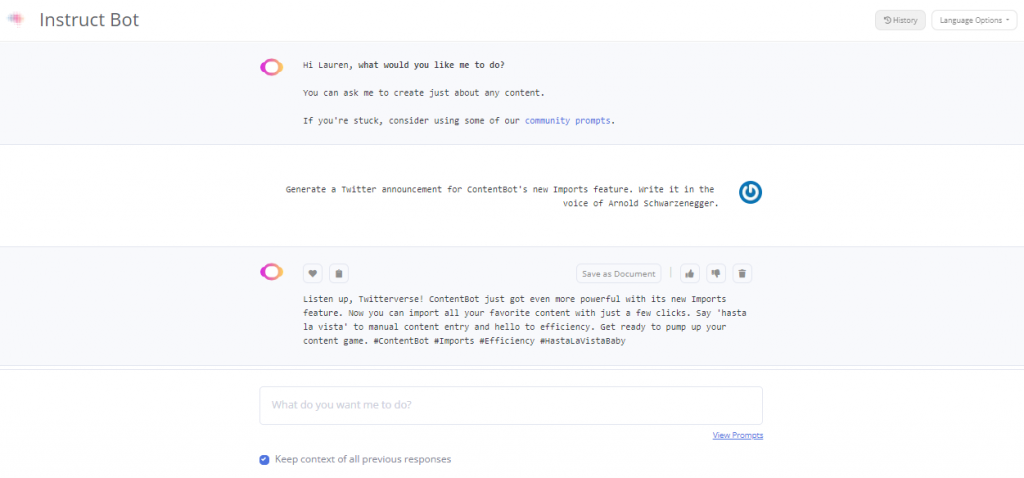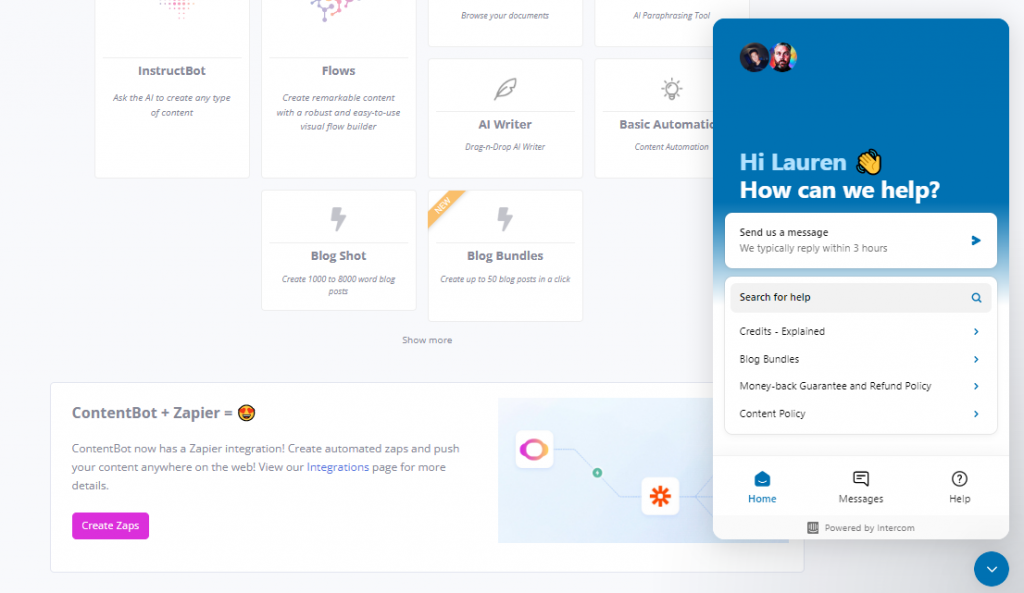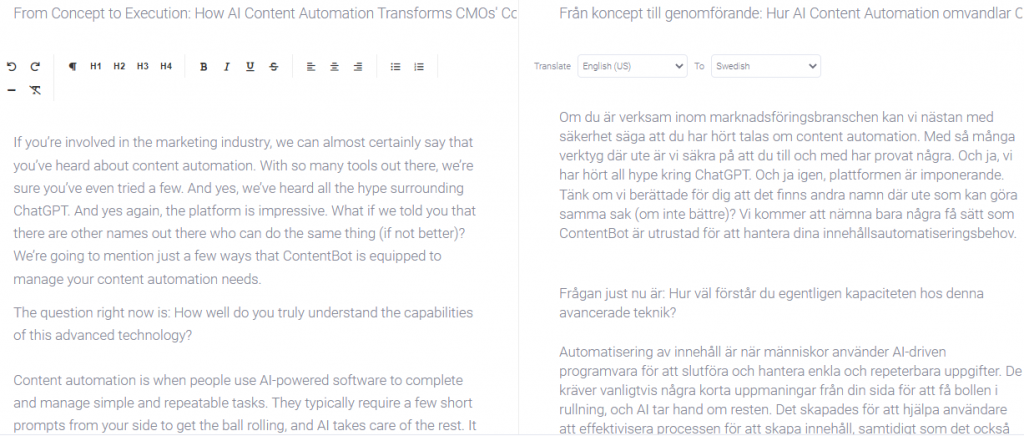The way that you create content says a lot about your brand. It’s the way that you convey information about your product or service to your audience. The content you put out there should always be unique, engaging and targeted. If you’re struggling to achieve this on a regular basis, then it may be time to look for a way to transform your content creation process.
We’re going to take a wild guess in saying that’s exactly why you’re reading this blog post. We should start by telling you that in the next five years, 74% of marketers will be using AI automation to complete at least one quarter of their work. It’s safe to say that when it comes to content automation, it’s sink or swim.
We’re going to show you 10 ways in which CMOs can transform their content creation process with AI content automation. Let’s start with a bit of an introduction.
What is AI Content Automation?
If you’re involved in the marketing industry, we can almost certainly say that you’ve heard about content automation. With so many tools out there, we’re sure you’ve even tried a few. And yes, we’ve heard all the hype surrounding ChatGPT. And yes again, the platform is impressive. What if we told you that there are other names out there who can do the same thing (if not better)? We’re going to mention just a few ways that ContentBot is equipped to manage your content automation needs.
The question right now is: How well do you truly understand the capabilities of this advanced technology?
Content automation is when people use AI-powered software to complete and manage simple and repeatable tasks. They typically require a few short prompts from your side to get the ball rolling, and AI takes care of the rest. It was created to help users streamline the content creation process, while also offering tools to optimize, distribute and manage the content.

Why is content creation so important?
How you create content depends on the image you want to portray to your audience. Whether you decide to use videos, social media, or blog posts, all content creation requires careful consideration. There are a few reasons why content creation shouldn’t be taken lightly:
Establish and increase brand awareness
Using a consistent style, tone and voice throughout your branding will help enhance credibility and trust for your brand. If you put a sufficient amount of time and effort into your content creation, you can increase your brand’s reach to new markets, and encourage sharing across social media platforms.
Drives traffic
Once you find a way to solve our audience’s problems, they will see the value in what you’re offering. High quality content will attract more viewers and lead to an increase in organic traffic. The way you nurture these leads plays an important role in conversion rates.
Builds trust and credibility
If you manage to stay ahead of the competition, you stand a better chance of being seen as a thought leader in your industry. This again enhances your credibility and gains the trust of viewers, enhancing your reputation even further.
Boost your SEO
The more time viewers spend on your site or platform, the lower your bounce rate. Bounce rate is a factor in determining your ranking on search engines results pages (SERPs). If what you are producing keeps your audience engaged for long enough, it can have a significant impact on your SEO. Make sure to pay attention to every-changing SEO trends.

How CMOs can use AI Content Automation to transform the Content Creation process
1. Idea generation
Whether you’re new to the world of marketing or have years of experience, this is a challenge we all face from time to time. People often say that creativity never runs out; that the more you use it, the more you have. Sometimes I’m not so sure.
We all know what it feels like when the creative well runs dry, or when you have a million and one things on your mind. Coming up with new, trendy, and engaging content day in and day out is challenging, demanding, and, let’s face it, exhausting at times.
Enter AI content automation!
There are a wide variety of tools on the market today, and each one is designed with the same goal in mind: to make marketers’ lives easier. You can use AI to generate everything from slogans and SMSs, to Tweets and email campaigns. What’s more, many tools even let you choose the voice behind your content. For example, if you want a new product launch to sound like it came from Arnold Schwarzenegger, simply type in your prompt and let the AI do what it does best.

2. Cut down research time
AI software goes through extensive programming, where it is fed vast amounts of data and information. Thanks to these resources, it’s capable of generating content around virtually any topic you can think of. While the facts do occasionally need to be cross-referenced to ensure accuracy, the information they provide is usually quite reliable.
The technology behind these platforms is mind-boggling! These machines are capable of sifting through and analyzing 100 times the amount of information that we could even begin to comprehend. Not to mention, they do it in a fraction of the time. Rather than spending hours conducting research on the top 10 marketing blogs to follow in 2023, you can ask the AI to retrieve the information for you. You will have the answers you need in a matter of seconds.
Let’s take another example. If you want to know what the most common use cases are for AI at the moment, why not ask InstructBot?

3. Generating social media posts
Some of the more advanced content automation tools are finding ways to integrate their software with different social media platforms. This way, the AI can analyze your user data and use it to generate new post ideas and content. If you go with a more comprehensive tool, then the machine will not only be able to write your post, it will be able to publish it and monitor its insights.
Let’s use ContentBot as an example. The developers have recently found a way to allow users to create their own custom workflows. This means that you can instruct the AI to follow a set of predetermined prompts at regular intervals; be it daily, weekly, or monthly. You are in complete control of when and how your content is produced. And the best part is, once you’ve set the ball in motion, you barely have to lift a finger to keep it going.
The Flows feature can be used to come up with ideas, generate relevant content around the idea, and put this content into action. What’s more, it will do this on a regular basis, while keeping track of your engagement metrics so that you don’t have to.

4. Creating product descriptions
If you have experience with marketing your product or service, then you inherently have experience as a salesman. The aim of all content is ultimately to generate sales and leads. While you might not always be making a direct sales pitch, you are still prompting your audience to take a desired action.
In saying that, trying to find ways to encourage people to make a purchase is not always straightforward. Many consumers are put off by hard-hitting sales messages. They may find them abrasive and intrusive at times. On the other hand, if you beat around the bush too much, your content may not pack a punch and have the desired effect. The best content results in the consumers taking the desired action, while letting them believe it was all their idea.

5. Writing email newsletters
Let’s talk about content curation. Content curation refers to the process of finding relevant, existing content and sharing it with your audience. This is one of the less popular uses for AI automation, and to be honest, it doesn’t receive the credit it deserves.
Many newsletters revolve around relaying the latest industry trends and news to subscribers. Wouldn’t it be great if you didn’t have to spend hours scanning the internet for relevant newsletter content? Well the good news is, you don’t!
Again, AI is capable of sifting through hours worth of content in a matter of minutes. With 328.77 million terabytes of data being created each day, having a tool like this in your wheelhouse could be a huge advantage. You can receive exactly what you were looking for straight to your desktop with just the click of a button. Once you are satisfied with the content pieces that will make up your newsletter, it’s time to generate the substance to go with it. AI can take care of that too.

6. Developing video scripts
In recent years, video marketing has dramatically increased in popularity. TikTok clearly became a huge hit, and Instagram released their new reels feature. Marketers are constantly finding new ways to take advantage of this craze. However, with so many competitors out there, the market has become quite saturated. We are continuously faced with the uphill battle for the viewers attention. Today’s viewers have much shorter attention spans, making this task anything but easy.
On the bright side, AI tools seem to be releasing new features on a regular basis. They are trying to find ways to help video marketers gain a competitive edge. You can now use them to generate video scripts and ideas. Some tools even help you upload your videos and edit them until you’re satisfied with the final result. Special effects no longer belong to blockbuster movies, but can be achieved by the everyday person with a computer.

7. Generating chatbot responses
Chatbots have been around for years. The technology is not new. What is new, however, is the way in which companies are using these developments.
Where chatbots were once simple and underwhelming, informative conversational chatbots have taken their place, and companies are figuring out how to use these developments to their advantage. This automation allows organizations to provide 24/7 customer service, regardless of the user’s location or time zone. Oftentimes, the AI is programmed with the company’s frequently asked questions and answers, or FAQs, in order to provide the most suitable answer to customers. This eliminates the need for human call center services and increases efficiency tenfold.
ChatGPT and ContentBot are some of the most popular chatbots around today. ContentBot’s InstructBot is also gaining momentum in the marketing world. By asking your question and prompting the AI, you will receive relevant and informative responses within seconds. You can also instruct the AI to perform certain tasks. These platforms were designed to give marketers creative freedom without breaking the bank.

8. Creating personalized content
Research has shown that today’s consumers want more personalized and tailored content. It has proven that an astounding 97% of businesses saw an increase in business outcomes after implementing personalization. A further 70% of businesses that use personalization recorded a 200% or higher return on investment.
The old method of “one shoe fits all” generic ads is not going to work in today’s market. That’s why businesses need to focus on the factors that influence consumer buying behavior, and provide personalized offers based on each customer’s specific needs and wants.
AI has already put businesses in the position where they no longer need to manually enter customer data in order to personalize their emails. But companies need to take it a step further. They should be considering ways to give their customers what they want, when and how they want it. Based on previous purchases, they should make specific recommendations to each person. Unique discounts can also be offered to customers who show a particular interest in certain products.
What’s more, when marketing their products and services, marketers need to pay attention to the demographics, culture, and personal views of their audience. That goes for their existing market and those that they wish to enter. Knowing who your audience is can be the difference between effective marketing and wasted resources.

9. Translating content
This is another underrated used for AI content automation. For businesses wishing to break into new markets, the potential benefits of using this technology are unprecedented.
Language barriers become a thing of the past with these automation tools. They also eliminate the need for human translators. This in turn saves the company large amounts of money that would otherwise be spent on paying these professionals. Now, they are able to generate whatever content they please, and translate in bulk with the push of a button.
You’ll be able to handle the entire content creation process, including translating into whichever language is required, from one central location. Again, this helps to improve the organization’s overall efficiency and money management.

10. Creating visual content
Ever since its introduction, this form of generative AI has become more advanced than most. As I mentioned before, AI is capable of analyzing huge quantities of information and data. To generate images, it uses machine learning to interpret images and resources, and identify patterns and styles within the context. This allows it to replicate what it’s been fed, while still adding a new and creative twist.
This development is quickly gaining momentum among marketers, as they no longer need to spend time and money searching for the perfect image to go with their campaigns. They’re also no longer limited to the image stock available on platforms like Unsplash. Now, they simply provide a brief description of the picture they want to create, and AI will make it happen. This gives them the opportunity to tailor their content to their needs, and to their audience’s. It’s now also easier to make sure that the visuals used in your marketing tactic suit your overall branding.
Companies need to acknowledge the potential behind this type of technology, before they fall behind on the trend.

The benefits of using AI content automation
- Increased Efficiency: AI content automation helps CMOs create content faster and more efficiently by automating repetitive and time-consuming tasks.
- Improved Quality: AI-powered tools can help CMOs create higher-quality content by providing real-time feedback and offering suggestions for improvement.
- Consistency: These automations ensure consistency across all marketing channels, and help maintain a cohesive brand voice.
- Increased Scalability: AI content automation allows CMOs to create and distribute content at a larger scale, without sacrificing quality.
- Data-Driven Insights: CMOs will be able to obtain valuable data insights about their content, audience, and marketing performance.
- Cost-Effective: These tools can significantly reduce the cost of content creation and distribution.
- Multilingual Support: AI content creation can help CMOs create content in multiple languages, allowing them to reach a wider audience.
So, what should you keep in mind?
There are a few factors that one should keep on mind when it comes to choosing the right content automation tools for your needs:
- Capabilities: Can the tool perform all the tasks that you require? Can it produce results on larger scales? Does it offer a wide variety of features?
- Flexibility: Can you quickly and easily make adjustments where necessary? What third party integrations does it offer?
- Learning curve: How easy is it to use? Will it require an abnormal amount of time to learn how to use the interface and finally reap the rewards?
- Cost: Remember, the goal is to increase scalability and cost-efficiency when using AI. Does the tool offer value for money services?
When it comes to content automation, we are only limited by our imagination. There are countless ways that AI can save you time, money, and manpower. This technology is rapidly shaping the future of eCommerce and other industries. If CMOs want to stay ahead of the curve and be seen as industry leaders, then this is one trend they should pay close attention to.
- How AI is Transforming the SEO Landscape: A Marketer’s Perspective - February 29, 2024
- How To Use AI For Keyword Research: A Marketer’s Guide - February 16, 2024
- The Impact of AI Writers on SEO Performance: Friend or Foe? - January 31, 2024
